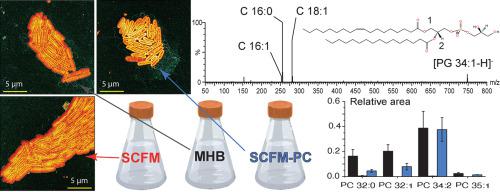Biochimica et Biophysica Acta (BBA) - Biomembranes ( IF 2.8 ) Pub Date : 2020-09-28 , DOI: 10.1016/j.bbamem.2020.183482 Estelle Deschamps , Annick Schaumann , Isabelle Schmitz-Afonso , Carlos Afonso , Emmanuelle Dé , Corinne Loutelier-Bourhis , Stéphane Alexandre

|
Background
Pseudomonas aeruginosa is a bacterium able to induce serious pulmonary infections in cystic fibrosis (CF) patients. This bacterium is very often antibiotic resistant, partly because of its membrane impermeability, which is linked to the membrane lipid composition. This work aims to study the membrane phospholipids of P. aeruginosa grown in CF sputum-like media.
Methods
Three media were used: Mueller Hilton broth (MHB), synthetic cystic fibrosis medium (SCFM) and 1,2-dioleoyl-sn-glycero-3-phosphocholine (DOPC) complemented SCFM (SCFM-PC). Lipids were extracted and LC-MS/MS analyses were performed. Growth curves, atomic force microscopy images and minimal inhibitory concentration determination were performed in order to compare the growth and potentially link lipid modifications to antibiotic resistance.
Results
Semi-quantification showed phospholipid quantity variation depending on the growth medium. Phosphatidylcholines were detected in traces in SCFM. MS/MS experiments showed an increase of phospholipids derived from DOPC in SCFM-PC. We observed no influence of the medium on the bacterial growth and a minor influence on the bacterial shape. MIC values were generally higher in SCFM and SCFM-PC than in MHB.
Conclusions
We defined a CF sputum-like media which can be used for the membrane lipid extraction of P. aeruginosa. We also showed that the growth medium does have an influence on its membrane lipid composition and antibiotic resistance, especially for SCFM-PC in which P. aeruginosa uses DOPC, in order to make its own membrane.
General significance
Our results show that considerable caution must be taken when choosing a medium for lipid identification and antibiotic testing —especially for phospholipids-enriched media.
中文翻译:

在囊性纤维化粘液模拟培养基中生长的铜绿假单胞菌的膜磷脂成分
背景
铜绿假单胞菌是一种能够在囊性纤维化(CF)患者中引起严重肺部感染的细菌。该细菌通常是抗生素抗性的,部分是由于其与膜脂质成分有关的膜不渗透性。这项工作旨在研究在CF痰样培养基中生长的铜绿假单胞菌的膜磷脂。
方法
使用了三种培养基:Mueller Hilton肉汤(MHB),合成囊性纤维化培养基(SCFM)和1,2-羟油酰基-sn-甘油-3-磷酸胆碱(DOPC)补充的SCFM(SCFM-PC)。提取脂质并进行LC-MS / MS分析。进行了生长曲线,原子力显微镜图像和最小抑菌浓度的测定,以比较生长情况,并可能将脂质修饰与抗生素抗性联系起来。
结果
半定量显示磷脂量根据生长培养基而变化。在SCFM中痕量检测到磷脂酰胆碱。MS / MS实验表明,SCFM-PC中源自DOPC的磷脂增加。我们没有观察到培养基对细菌生长的影响,对细菌形状的影响也很小。SCFM和SCFM-PC中的MIC值通常高于MHB。
结论
我们定义了一种CF痰样培养基,可用于铜绿假单胞菌的膜脂提取。我们还表明,生长培养基确实对其膜脂质组成和抗生素抗性有影响,特别是对于其中铜绿假单胞菌使用DOPC来制造其膜的SCFM-PC 。
一般意义
我们的结果表明,在选择用于脂质鉴定和抗生素测试的培养基时,尤其是富含磷脂的培养基时,必须格外小心。











































 京公网安备 11010802027423号
京公网安备 11010802027423号